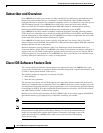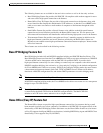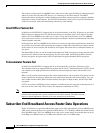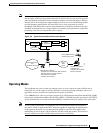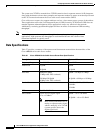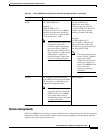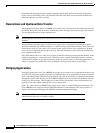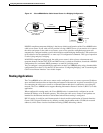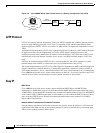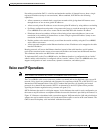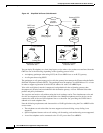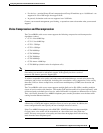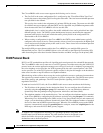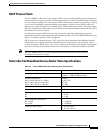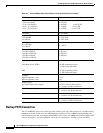
Configuring Subscriber-End Broadband Access Router Features
Subscriber-End Broadband Access Router Data Operations
MC-612
Cisco IOS Multiservice Applications Configuration Guide
The system uses TCP/IP to transmit data. TCP/IP transmits data in segments encased in IP datagrams,
along with checksums to detect data corruption and sequence numbers to ensure an ordered byte stream
on the TCP connection between the Cisco cable access router and the CMTS.
Cisco cable access routers also support multicast services—data streams sent to groups of subscribers.
These applications utilize the User Datagram Protocol (UDP) instead of TCP. Because UDP does not
mandate upstream acknowledgments, these applications can be very efficient in the network.
Additionally, restricting upstream throughput will have no effect on downstream UDP streaming
throughput.
Note Interactive games are the exception. Although low latency is required in gaming
applications, high upstream data throughput is not demanded because the volume of data
transmitted upstream is typically small.
Data Specifications
Table 37 provides a summary of the upstream and downstream transmission characteristics of the
Cisco uBR900 series cable access routers.
Table 38 Cisco uBR900 Series Cable Access Router Data Specifications
Description Downstream Values Upstream Values
Frequency Range 88 to 860 MHz 5 to 42 MHz
Modulation 64 QAM
256 QAM
QPSK
16 QAM
Data Rate 30 Mbps/64 QAM
(27 Mbps after FEC overhead)
42.8 Mbps/256 QAM
(36 Mbps after FEC overhead)
QPSK—320 kbps to 5 Mbps
16 QAM—640 kbps to 10 Mbps
Bandwidth 6 MHz 200 kHz, 400 kHz, 800 kHz,
1.6 MHz,
3.2 MHz
FEC RS (122, 128) Trellis Reed Solomon
One Channel Receive level of digital signal
–15 to +15 dBmV
Note Most field measurements are of
nearby or adjacent analog signal
which is normally +6 to +10 dB
(system specific) above the
digital signal level.
QPSK— +8 to +58 dBmV
16 QAM— +8 to +55 dBmV




